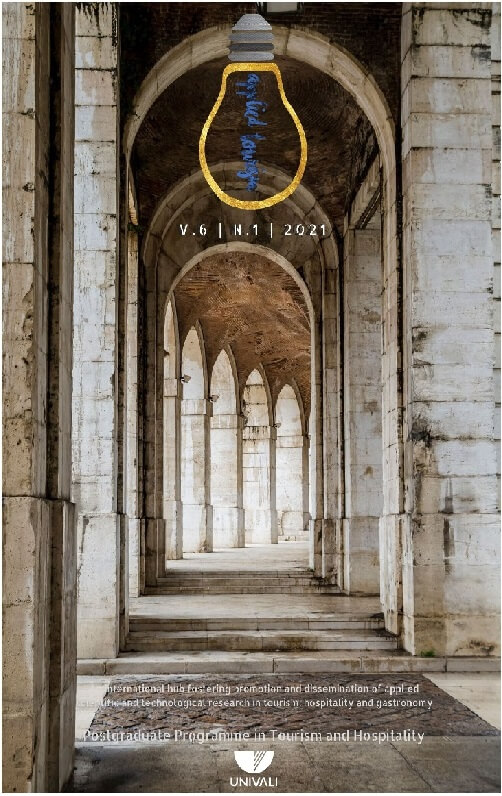GUIDED TOUR: IN THE WAYS OF HALF A CENTURY OF HISTORY OF THE FIRST HOTEL-SCHOOL OF LATIN AMERICA.
DOI:
https://doi.org/10.14210/at.v6n1.p59-66Palabras clave:
Heritage, History, Guided tour, Hotel School.Resumen
This work is the result of experiences lived during the stages of the project "Interpreting the ways of the Hotel-School Senac Grogotó: thematic routes as tools to promote the appreciation of the history and heritage preservation in Senac unit in Barbacena-MG." The project was developed under the extension program of the Technology School of Senac Minas, together with the graduation courses of technology in hospitality and gastronomy. The project is characterized by offering thematic routes, structured as a guided tour, which are conducted by students of the institution in order to present the history and the heritage of the hotel, aiming to sensitize students, guests and other social groups in the community. The development of research and data collection took place between July 2016 and July 2017, and currently the project is still active, with the visits already implemented, as will be seen in the topic Methodology. The methodology used was the exploratory research and intervention research. For this, information was collected from various sources of research that enabled the formatting of a tour script, which was categorized and sectorized. Within this context, it was aimed through the formatting of the guided tour the consolidation of guidelines and methodologies for the reception of groups. This initiative intended to professionalize and expand the visitation to the complex of Hotel School Grogotó. The consolidation project in Barbacena Senac unit is an effective strategy to publicize the heritage and also the educational expertise of the institution, especially in the theme of hospitality. As a result, it provided the recognition and revaluation of historical and cultural aspects of the 1st Hotel-School in Latin America, offering to Barbacena community and other interested parties educational and entertainment opportunities. The guided tour is formatted in seven points of interpretation, and along the route the places of the Hotel-School that present as relevant spaces in the professional technical training since the year 1960 are visited. In this sense, the project contributes to creating places for students and teachers to experience and materialize the construction of a more inclusive and participatory society, providing the transforming relationship between school and society, establishing the exchange of academic and popular knowledge, in order to democratize the knowledge produced in the classroom. Finally, the project opens the space for participation of the community in the Hotel-School in a more significant way.
Citas
Brazil. (2010). Ministry of Tourism Segmentation of tourism and the market. Brasilia: Ministry of Tourism.
Chaoay, F. (2011).The allegory of the equity. St. Paul: Liberty Station, Publisher Unesp.
Coutinho, Z.,& Matos et al.(2017). Interpreting Grogotó paths. In the Mining Journal Beginnings Kitchen: History at the table. Belo Horizonte: Senac. v, 5, n.1, pp.98-117.
Steps, E., & Barros B.R. (2000). Construction of the clinical plan and the concept of transdisciplinarity. Psychology: Theory and Research. v. 16, no. 1, p. 71-79.
Pucci, P. R., Bannach.,& Cardozo, P.F.(2008). interpretive planning of historical and architectural cultural heritage of the central city of Castro-PR. Tourism and Society, vol. 1, no. 2,
Morales, J. (2004). La interpretación en su acepción de comunicación attractive situ. Cultural Bulletin Gestión, v. 8,
Murta, S. M., & Goodey, B. (1995). Heritage interpretation for Sustainable Tourism - A Guide. Belo Horizonte: SEBRAE (MG).
Descargas
Publicado
Número
Sección
Licencia
Neste termo de responsabilidade certifico(amos) que participei(amos) da elaboração do artigo anexo, desta forma tornando pública a minha(nossa) responsabilidade pelo seu conteúdo. Declaro(amos) que não omitimos quaisquer ligações ou acordos de financiamento entre eu (nós) e entidades e / ou instituições que possam ter interesse na publicação deste artigo. Certifico(amos) que o artigo é original e que o trabalho, no todo ou em parte, ou qualquer outro trabalho com conteúdo substancialmente similar, de minha (nossa) autoria, não foi enviado a outro periódico e não o serão enquanto sua publicação estiver sendo considerada pela Applied Tourism, em qualquer formato (impresso ou eletrônico). Neste termo de consentimento, os autores relacionados dão permissão à Applied Tourism, no caso de aprovação pelo Conselho Editorial dessa, para a publicação do artigo anexo em cópia impressa e/ou eletrônica em edição regular da revista, e para o envio a base de dados.
Você tem o direito de:
- Compartilhar — copiar e redistribuir o material em qualquer suporte ou formato
- Adaptar — remixar, transformar, e criar a partir do material
- para qualquer fim, mesmo que comercial.
- O licenciante não pode revogar estes direitos desde que você respeite os termos da licença.
De acordo com os termos seguintes:
Atribuição — Você deve atribuir o devido crédito, fornecer um link para a licença, e indicar se foram feitas alterações. Você pode fazê-lo de qualquer forma razoável, mas não de uma forma que sugira que o licenciante o apoia ou aprova o seu uso.
CompartilhaIgual — Se você remixar, transformar, ou criar a partir do material, tem de distribuir as suas contribuições ao abrigo da mesma licença que o original.
- Sem restrições adicionais — Você não pode aplicar termos jurídicos ou medidas de caráter tecnológico que restrinjam legalmente outros de fazerem algo que a licença permita.










